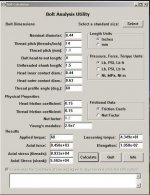I can't seem to find the answer on this question. Are the bolts that attach the crankshaft main bearing halves self locking (are they the stretch bolts like the flywheel bolts)? As far as I can tell they are used only in two places on my car - the flywheel and the connecting rod big end. The reason I ask is my car did not have any split washer on the crankshaft mains and I see in the books they are supposed to have them. I also assume that if they are self locking them they would not use split washers - is that correct? I am aware that earlier cars had tab lock washers. I want to order new ones (I should shouldn't I?) if they are stretch bolts but will not need to if all I need to replace is the lock washers. I always seem to get salesmen who don't know the answers to my questions at the place I was going to order from so I will rely on your answers.
-
The Roadster Factory Recovery Fund - Friends, as you may have heard, The Roadster Factory, a respected British Car Parts business in PA, suffered a total loss in a fire on Christmas Day. Read about it, discuss or ask questions >> HERE. The Triumph Register of America is sponsoring a fund raiser to help TRF get back on their feet. If you can help, vist >> their GoFundMe page.
-
 Hey there Guest!
Hey there Guest!
If you enjoy BCF and find our forum a useful resource, if you appreciate not having ads pop up all over the place and you want to ensure we can stay online - Please consider supporting with an "optional" low-cost annual subscription.**Upgrade Now**
(PS: Subscribers don't see this UGLY banner)
TR4/4A Self locking bolts question
- Thread starter bammons
- Start date
Share this page
Similar threads
Similar threads
-
-
-
-
-
-
-
-
-
-
-
-
-
-
-
-
-
-
-
-
-
-
G
-
G
-
-
-
-
-
-
TR2/3/3A Front brake calipers locking up when pressing on brake.
- Started by John_Koop
- Replies: 18
-
-
-
-
-
-
-
Source for return spring on Early BN4 locking door handle?
- Started by RichsBN4
- Replies: 1
-
D
-
-
-
-
-
-
-
-
-
-
-
V
-
-


 smilie in place of the real @
smilie in place of the real @
 Pretty Please - add it to our Events forum(s) and add to the calendar! >>
Pretty Please - add it to our Events forum(s) and add to the calendar! >> 



 A friendly reminder - be careful what links you click on here. If a link is posted by someone you don't know, or the URL looks fishy, DON'T CLICK. Spammers sometimes post links that lead to sites that can infect your computer, so be mindful what you click.
A friendly reminder - be careful what links you click on here. If a link is posted by someone you don't know, or the URL looks fishy, DON'T CLICK. Spammers sometimes post links that lead to sites that can infect your computer, so be mindful what you click.